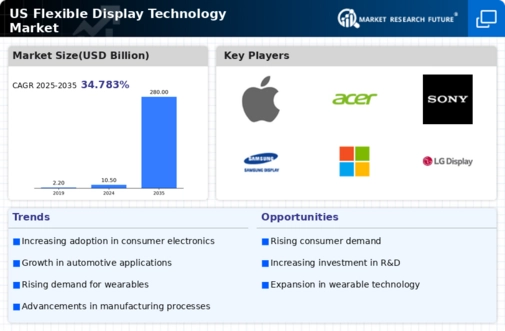Expansion of Automotive Applications
The flexible display-technology market is poised for growth due to the increasing integration of flexible displays in automotive applications. As the automotive industry evolves towards more advanced infotainment systems, flexible displays offer unique advantages such as lightweight design and adaptability to various surfaces. It is estimated that the automotive sector could represent around 20% of the flexible display-technology market by 2025. This shift is driven by consumer demand for enhanced in-car experiences, including larger screens and customizable interfaces. Additionally, the potential for flexible displays to be used in head-up displays and dashboard interfaces indicates a promising future for this technology within the automotive sector.
Increased Focus on Smart Home Devices
The flexible display-technology market is benefiting from the rising interest in smart home devices. As consumers seek to enhance their living spaces with technology, flexible displays are being integrated into various smart home applications, including smart mirrors and interactive kitchen displays. This integration allows for seamless user interaction and enhances the overall aesthetic of home environments. Market forecasts suggest that the smart home segment could represent approximately 15% of the flexible display-technology market by 2025. The growing trend towards home automation and connectivity is likely to drive further innovation and adoption of flexible display technologies in this sector.
Rising Demand for Wearable Technology
The flexible display-technology market is experiencing a notable surge in demand for wearable devices. As consumers increasingly seek innovative solutions for health monitoring and fitness tracking, manufacturers are integrating flexible displays into smartwatches and fitness bands. This trend is projected to drive the market, with estimates suggesting that the wearable technology segment could account for approximately 30% of the overall flexible display-technology market by 2026. The ability to create lightweight, durable, and visually appealing devices is crucial, as it enhances user experience and functionality. Furthermore, the growing emphasis on health and wellness is likely to propel investments in this sector, thereby fostering advancements in flexible display technologies that cater to the specific needs of consumers.
Growth in E-commerce and Digital Advertising
The flexible display-technology market is being propelled by the rapid growth of e-commerce and digital advertising. As businesses increasingly shift towards online platforms, the need for eye-catching and dynamic advertising solutions has become paramount. Flexible displays offer unique opportunities for interactive and engaging advertisements, which can enhance consumer engagement. It is anticipated that the digital advertising sector will contribute significantly to the flexible display-technology market, potentially accounting for 25% of the market share by 2026. This trend underscores the importance of innovative display solutions in capturing consumer attention and driving sales in a competitive online environment.
Technological Innovations in Display Manufacturing
Technological advancements in display manufacturing are significantly influencing the flexible display-technology market. Innovations such as organic light-emitting diode (OLED) technology and improved production techniques are enhancing the quality and efficiency of flexible displays. These advancements are expected to reduce production costs, making flexible displays more accessible to a broader range of industries. Market analysts project that by 2027, the cost of manufacturing flexible displays could decrease by up to 15%, thereby stimulating demand across various sectors, including consumer electronics and advertising. As manufacturers continue to refine their processes, the flexible display-technology market is likely to benefit from increased competition and improved product offerings.






















Leave a Comment